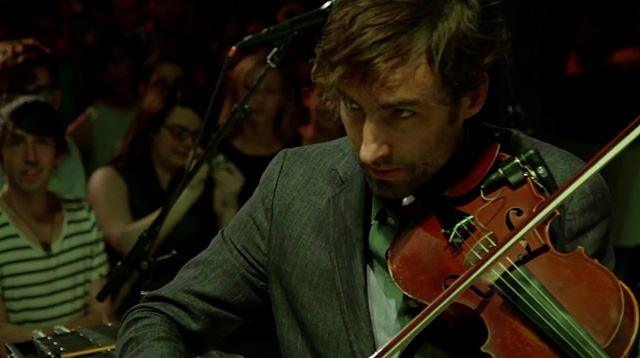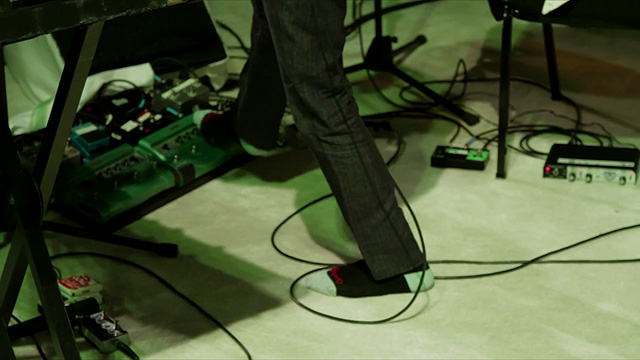On the surface this may seem like an unlikely interview. I mean, we’re a tech blog and Andrew Bird is a musician. But beneath the organic and strikingly analog sounds of Mr. Bird’s beautiful music there is this whole sea of technology at work — especially during live solo performances.
Andrew was kind enough to take some time out of his touring schedule on the eve of the release of his new album called Break It Yourself in order to tell me a bit more about the different gadgets and pedals he uses to achieve his unique sound and also about his vision and approach to making music. An approach where technology is involved, but is certainly not the master.
TC:
Before we get started, I thought maybe you could, in your own words, describe your music for people who may not be familiar.
AB:
Well, my main instrument is violin, but I think of myself as a songwriter who happens to play violin. I also play guitar. I will often times loop my violin to expand the instrument beyond its linear restrictions. So I do a lot of live looping and manipulate the instrument to get a wider set of sounds — from double bass to metallic sounds.
I loop my voice as well. I also play with a drummer who is a master looper, so there’s a lot of “on the fly” expanding of our instruments on stage. It’s not like we’re trying to replace a band or anything, we’re just using it as a tool to expand our instruments. So there’s a lot of improvisation and a lot of going off-script.
TC:
This is probably true of most live performances, but especially so with yours…because of the way you have loops set, every performance could be totally unique?
AB:
Yeah, I mean not only is there improvisation, but there is that element of the unknown with the looping. Nothing is “on time”. Nothing is fixed or fit to a grid or corrected. It’s all subject to human error. So I could loop a pizzicato pattern and then I’ll press the button again and I’ll keep recording on top of it and I can create these polyrhythmic patterns.
Then I’ll try to find a way to fit new parts into these patterns. And you end up with this big tapestry of sound that you wouldn’t get from a traditional band setup.
My drummer has his own looping pedals and keyboards and sometimes I sync with the loops he makes. In other cases, I am just making a loop and hoping for the best with the rest of the band. But to answer the original question…it’s quite different from night to night. It’s almost like a cultivated precariousness.
TC:
That leads to my next question. There is this really “human” element to your music. There is all this looping and sampling going on, but there seems to be some kind of dichotomy between all the vintage instruments you play and then this abundant technology that you use to create your music at the same time. So, I guess I was wondering if you think that is a dichotomy or does that matter at all? How do you feel about that?
AB:
I never really thought of it as a dichotomy. I’ve always found that anything that makes the process too ceremonious — like going across the room and pressing play and record — changes the music (and not always for the better).
So there’s something about it being un-fussy and intuitive. I mean, it’s just a click of a button with my foot. And the other key thing is it doesn’t save my ideas. If I want to get a new idea, the thing I am currently playing has to be erased. Something about that keeps it just ephemeral enough that you don’t get to precious about your ideas…and it just remains “on the fly”.
So I think of it almost like a robotic arm or something with my nerve endings kind of attached to this piece of technology that lets me go beyond the linear restrictions of the violin.
TC:
It’s an extension. Something you still control.
AB:
Yeah. It’s become very second nature. I hardly play the violin without [the loops]. You know, the violin, for years, was just kind of grafted onto my arm and that was second nature. And now this technological extension…I’m still physically involved in making the sounds happen [e.g. it’s not like it is all electronics and sequencing]. Now its just integrated into how I play.
TC:
Now onto the “geekery” question. I was watching one of your performances. The one at the Guggenheim Museum in New York City. There’s a shot where you can see about twenty five pedals at your feet. What is one of those key pedals in your setup?
AB:
There aren’t really that many. A lot of guitarists have more than I have. But basically I have two rigs, meaning, I have two streams. There’s one looping pedal — a Line 6 [DL4] — that goes to one amp (and that’s for pizzicato playing) and then I have another Line 6 pedal that’s going to another amp with a spinning speaker that’s for arco playing…for the bowed stuff. So one is rhythmic and one is ambient.
So the Line 6 pedals are the key instrument in that setup. And then I use an analog octave pedal to get bass sounds and fairly realistic sounding cello sounds. And then I use these custom pedals that turn the violin into almost an African imbura…kind of a percussive, filtered sound. And really that’s about it.
I have a vocal mic that I also feed into the Line 6 looping pedal. Sometimes I whistle into it to get it into the loop. And then sometimes I send a feed to my drummer on stage for him to alter with his own looping pedals.
For the Guggenheim thing… that was all solo. We just did the Sonic Arboretum show in Chicago and for that we hooked up my pedal board to a Tascam X-48 Hard Disk Recorder and you have 48 [lines] out, so we could create this matrix of channels going out to these groups and clusters of [speaker] horns.
It’s still on the fly, except I’m working with this engineer who is taking my ideas and refining them to different outputs. He can pan them and mix them so it creates a different movement coming from the stage. So that is the next phase we are working on now with extending the instrument through technology.
TC:
Yeah, in the Guggenheim video, there are all these Victrola-esque speaker horns everywhere. All throughout the audience. Some were turning and had motors on them.
AB:
That’s called the Janus Horn — more like a Doppler effect. We’re working with Ian Schneller who makes these horns and is developing new shapes like spiral helix horns. Some are like pendulums. But many of the horns are just static speakers.
TC:
What’s one of the ways you search for new sounds? Are you a pawn shop guy looking for old vintage pedals?
AB:
I’ve slowly gathered these pedals and I am careful about adding any more. I’m careful about going overboard with the pedals. I try to keep it within the realm of what I can manage. There’s a lot of sound I am trying to manage and it needs to be streamlined.
So I’m not a gear head. I don’t search out pedals, but now that I have my palette to work from…you know, it has to be a Boss OC2 which they don’t make anymore. So I do have to seek out these pedals on eBay. Or the Blister Agent…there are like 30 in existence, so I have to find the guy who makes them and order more.
I don’t even go as far as to get a volume pedal. I still just take off my shoes and and dial with my toes. For some reason I just thought adding that volume pedal would put me over the edge of what I could still manage.
In that sense there’s that dichotomy again. I don’t want technology to take me so far that I don’t have to use my brain anymore. It’s like GPS taking over and losing your internal compass. It’s always got to be tactile, still organic. There still has to be the possibility that it could all come crashing down.
I am working with my brother, who is an electrical engineer, and we are working on a custom looping pedal that has some special features that I could use.
TC:
Tell us about the new record. When is it coming out.
AB:
It’s coming out March 6th. It’s called Break It Yourself. It was all recorded in one room with four musicians and an old Tascam reel-to-reel tape recorder. It had seven working tracks, so we recorded the whole record with seven tracks.
We used a Yamaha board — really, nothing fancy even in a vintage sense. It was decent and well-maintained equipment from the early 70s. We had seven tracks and that’s a lot of limitation to make a recording. Again, the looping is all in there. It was all live and was captured so it sounds like more than four musicians. There are no overdubs.
TC:
Really? That’s pretty interesting. All that happened live and “before the board”?
AB:
Yeah.
TC:
Impressive.
AB:
Yeah, I had this argument with a french journalist from an electronic music magazine. I said, “there’s no production on this” and he said “you’re lying”. It’s like you said it’s “before the tape” and I don’t consider that production.
That’s the way I make music on stage and I don’t think of that as production. I mean, anything can be “production” and that is a mentality of a lot of modern music…”we’ll just fix it in post-production”. And a lot of producers work that way. It’s terrible for music.
TC:
I agree. It’s sort of the easy way out these days. The “cut and paste” thing.
AB:
Yeah. It really leads to a kind of static, stale, everything-on-the-grid sound. It sounds like a series of choices instead of music. So I just wanted to avoid that feeling at all costs.
TC:
On the new record, Hole In The Ocean Floor, Eyeoneye and Danse Caribe are some of my favorites. Even some of the interludes like Polynation are very interesting and ethereal and haunting. Is there one on the new record that is your favorite?
AB:
I really like Fatal Shore because it has such a nice feel to it. It is so far back on the beat. It’s a really illusive kind of thing to nail and I just like the way Martin [Dosh] is playing on that song. It was really late at night and everyone was exhausted and it’s just got that unhurried, humid sound to it.
TC:
Worn out?
AB:
Yeah.
TC:
Where can people find more information about this new record?
AB:
You can go to andrewbird.net. There are also some interactive features there. Like, one of the jams from the barn recording…we separated the tracks and you can mix the sounds yourself and interact with it.
TC:
Ok, Andrew Bird, thanks very much for taking the time to talk with us here at TechCrunch and we’ll look forward to seeing you out there on the road somewhere looping some great songs.
AB:
Ok, thanks Jay.

